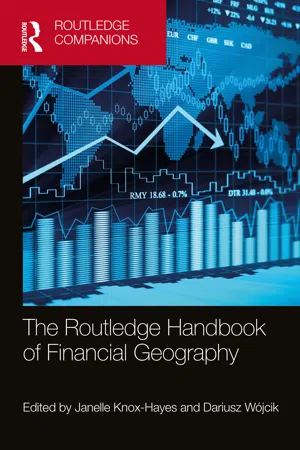
- 710 pages
- English
- PDF
- Available on iOS & Android
The Routledge Handbook of Financial Geography
About This Book
This handbook is a comprehensive and up to date work of reference that offers a survey of the state of financial geography. With Brexit, a global recession triggered by the COVID-19 pandemic, as well as new financial technology threatening and promising to revolutionize finance, the map of the financial world is in a state of transformation, with major implications for development.
With these developments in the background, this handbook builds on this unprecedented momentum and responds to these epochal challenges, offering a comprehensive guide to financial geography. Financial geography is concerned with the study of money and finance in space and time, and their impacts on economy, society and nature. The book consists of 29 chapters organized in six sections: theoretical perspectives on financial geography, financial assets and markets, investors, intermediation, regulation and governance, and finance, development and the environment. Each chapter provides a balanced overview of current knowledge, identifying issues and discussing relevant debates. Written in an analytical and engaging style by authors based on six continents from a wide range of disciplines, the work also offers reflections on where the research agenda is likely to advance in the future.
The book's key audience will primarily be students and researchers in geography, urban studies, global studies and planning, more or less familiar with financial geography, who seek access to a state-of-the art survey of this area. It will also be useful for students and researchers in other disciplines, such as finance and economics, history, sociology, anthropology, politics, business studies, environmental studies and other social sciences, who seek convenient access to financial geography as a new and relatively unfamiliar area. Finally, it will be a valuable resource for practitioners in the public and private sector, including business consultants and policy-makers, who look for alternative approaches to understanding money and finance.
Frequently asked questions
Table of contents
- Cover
- Half Title
- Series Page
- Title Page
- Copyright Page
- Dedication
- Table of Contents
- List of Figures
- List of Tables
- List of Contributors
- Acknowledgments
- Chapter 1: Introduction
- Part I: Theoretical Perspectives in Financial Geography
- Part II: Financial Assets and Markets
- Part III: Investors
- Part IV: Intermediation
- Part V: Regulation and Governance
- Part VI: Finance, Development and the Environment
- Index